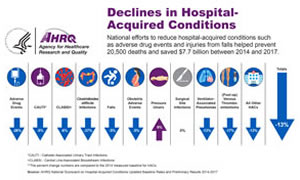AHRQ Analysis Finds Hospital-Acquired Conditions Declined By Nearly 1 Million from 2014-2017
HHS Initiatives Continue to Improve Patient Safety
New data released today by the Agency for Healthcare Research and Quality (AHRQ) and Centers for Medicare & Medicaid Services (CMS) show reductions in hospital-acquired conditions such as adverse drug events and healthcare-associated infections helped prevent 20,500 hospital deaths and save $7.7 billion in health care costs from 2014 to 2017.
AHRQ’s preliminary analysis (PDF, 545 KB) estimates that hospital-acquired conditions were reduced by 910,000 from 2014 to 2017. The estimated rate of hospital-acquired conditions dropped 13 percent; from 99 per 1,000 acute care discharges to 86 per 1,000 during the same timeframe.
 AHRQ’s new report quantifies trends for several hospital-acquired conditions, including adverse drug events, catheter-associated urinary tract infections, central-line associated bloodstream infections, Clostridioides difficile infections, pressure injuries (pressure ulcers), and surgical site infections. The report showed that harms decreased in several categories, such as adverse drug events, which dropped 28 percent from 2014 to 2017. However, opportunities for improvement exist in other harm categories, such as pressure ulcers.
AHRQ’s new report quantifies trends for several hospital-acquired conditions, including adverse drug events, catheter-associated urinary tract infections, central-line associated bloodstream infections, Clostridioides difficile infections, pressure injuries (pressure ulcers), and surgical site infections. The report showed that harms decreased in several categories, such as adverse drug events, which dropped 28 percent from 2014 to 2017. However, opportunities for improvement exist in other harm categories, such as pressure ulcers. “CMS is delivering on improving quality and safety at America’s hospitals,” said CMS Administrator Seema Verma. “Our work isn’t done and we will continue our efforts to hold providers accountable for delivering results.”
AHRQ Director Gopal Khanna, MBA, added, “The updated estimates are a testament to the successes we’ve seen in continuing to reduce hospital-acquired conditions. There’s no question that challenges still remain in addressing the problem of hospital-acquired conditions, such as pressure ulcers. But the gains highlighted today were made thanks to the persistent work of many stakeholders’ ongoing efforts to improve care for all patients.”
The continued decline in hospital-acquired conditions is a signal that patient safety initiatives led by CMS are helping to make the Nation’s health care safer, Federal officials said. AHRQ, CMS, the Centers for Disease Control and Prevention, and other Federal and private partners throughout the field support ongoing improvements in health care and are establishing a growing foundation of knowledge about how to keep patients safe. AHRQ has developed a variety of patient safety tools and resources, including the Comprehensive Unit-based Safety Program, to reduce hospital-acquired conditions. CMS has sustained and accelerated the national progress and momentum toward continued harm reduction in the Medicare program.
CMS, through the Hospital Improvement Innovation Networks (HIINs), works to instill best practices in harm reduction to more than 4,000 of the Nation’s acute care hospitals. The HIINs regularly engage with hospitals, providers, and the broader caregiver community to quickly implement evidence-based practices in harm reduction to improve the quality of care for Medicare beneficiaries. The agency further supports evidence-based harm-reduction strategies through the Quality Improvement Network-Quality Improvement Organizations (QIN-QIOs) and the End Stage Renal Disease Network Program.
CMS has set a goal of reducing hospital-acquired conditions by 20 percent between 2014 and 2019. If achieved, AHRQ projects the 20 percent reduction would result in 1.8 million fewer hospital-acquired conditions over this period, potentially resulting in 53,000 fewer deaths and saving $19.1 billion in hospital costs.
HHS agencies will continue working to build on these promising results—improving patient safety and reducing health care costs while seeking to ensure the highest quality care to patients.
To view the AHRQ report titled, AHRQ National Scorecard on Hospital-Acquired Conditions Updated Baseline Rates and Preliminary Results 2014-2017 please visit: https://www.ahrq.gov/sites/default/files/wysiwyg/professionals/quality-patient-safety/pfp/hacreport-2019.pdf (545 KB).
To view infographics from AHRQ, please visit: https://www.ahrq.gov/data/infographics/index.html
Contact:
CMS Media Relations
(202) 690-6145
(202) 690-6145
Page last reviewed January 2019
Page originally created January 2019
Page originally created January 2019
Internet Citation: AHRQ Analysis Finds Hospital-Acquired Conditions Declined By Nearly 1 Million from 2014-2017. Content last reviewed January 2019. Agency for Healthcare Research and Quality, Rockville, MD. http://www.ahrq.gov/news/newsroom/press-releases/hac-rates-declined.html





















.jpg)









No hay comentarios:
Publicar un comentario